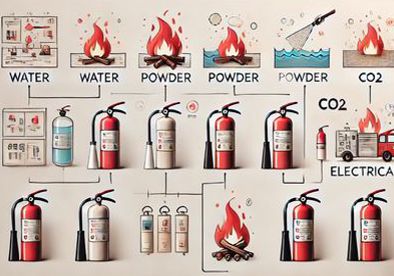Home / Articles / Comparison of fire extinguishing systems, water, gas, powder
Comparison of fire extinguishing systems, water, gas, powder

Automatic fire extinguishing systems are selected taking into account the specifics of the protected object, the types of possible fires, the availability of people and equipment. Three types are most widely used: water, gas and powder installations. The following is an analysis of their advantages and limitations with practical recommendations for use.
Water fire extinguishing systems
Water systems operate by supplying water through sprinklers or drain sprinklers. They are activated when the temperature rises or by a signal from an automatic fire alarm system.
Advantages:
- high fire extinguishing efficiency of classes A (solid combustible materials) and partly B (liquids);
- availability of water as a fire extinguishing agent;
- automation and ease of maintenance;
- reliability and long service life of the equipment.
Disadvantages:
- inability to use when extinguishing electrical appliances under voltage (Class E fires);
- risk of water damage to appliances, furniture, and finishes;
- They are ineffective in rooms with low temperatures — pipes may freeze.
Recommended use: sales halls, warehouses with combustible materials, administrative buildings, garages. They are not suitable for server rooms, archives, or libraries.
Gas fire extinguishing systems
Gas installations use inert gases or chemically active compounds that extinguish a fire by displacing oxygen or cooling the ignition source. Examples: carbon dioxide (CO₂), FM-200, Novec 1230.
Advantages:
- no damage to property (no traces remain after activation);
- suitable for extinguishing electrical equipment and flammable liquids;
- fast and uniform filling of the protected volume;
- they can work indoors without people.
Disadvantages:
- high cost of equipment and refueling;
- the need to seal rooms;
- carbon dioxide can be dangerous to humans at high concentrations.
Recommended use: server rooms, data centers, storage facilities, museums, archives, telecommunication hubs.
Powder fire extinguishing systems
Powder installations use finely dispersed powders that block oxygen access to the gorenje. They are effective against most classes of fires, including electric ones.
Advantages:
- versatility — extinguishing fires of classes A, B, C and E;
- quick effect in case of local fires;
- resistance to subzero temperatures;
- the possibility of modular placement.
Disadvantages:
- contamination of premises and equipment with powder;
- the need for complete cleaning of the protected space after operation;
- there may be breathing problems for people in the area of operation.
Recommended use: industrial premises, workshops, transformer substations, motor transport.
| Order the installation of fire extinguishing systems
18.04.2025
372 👁